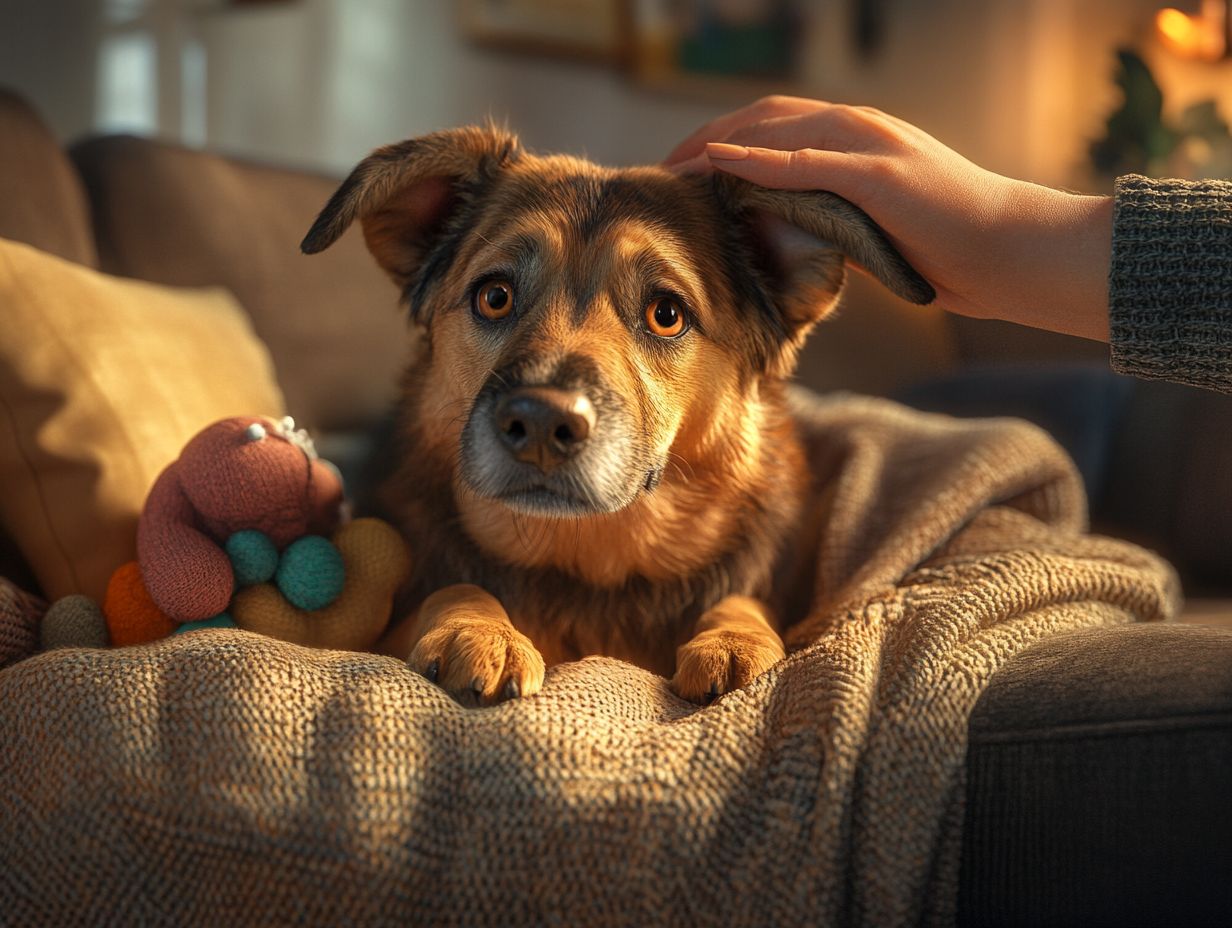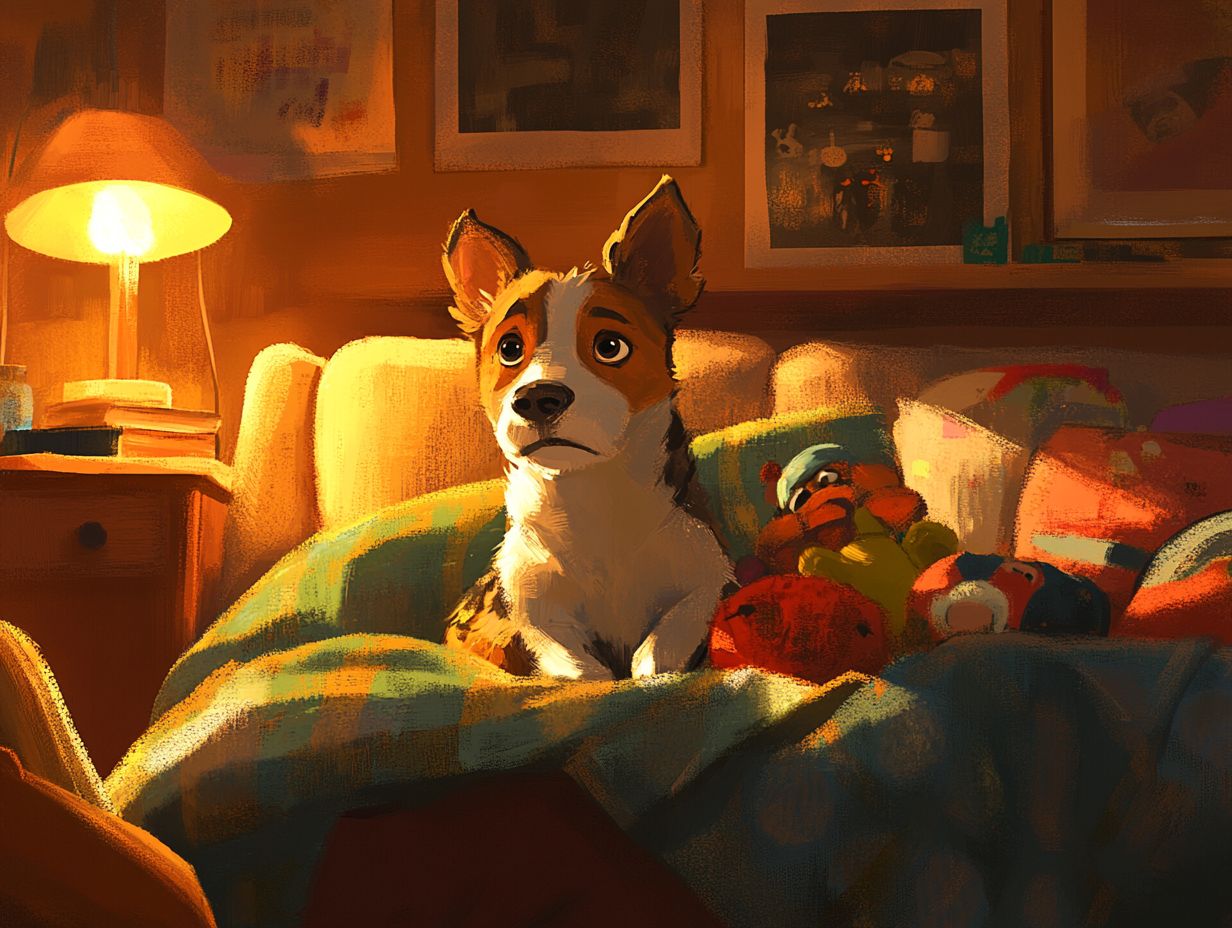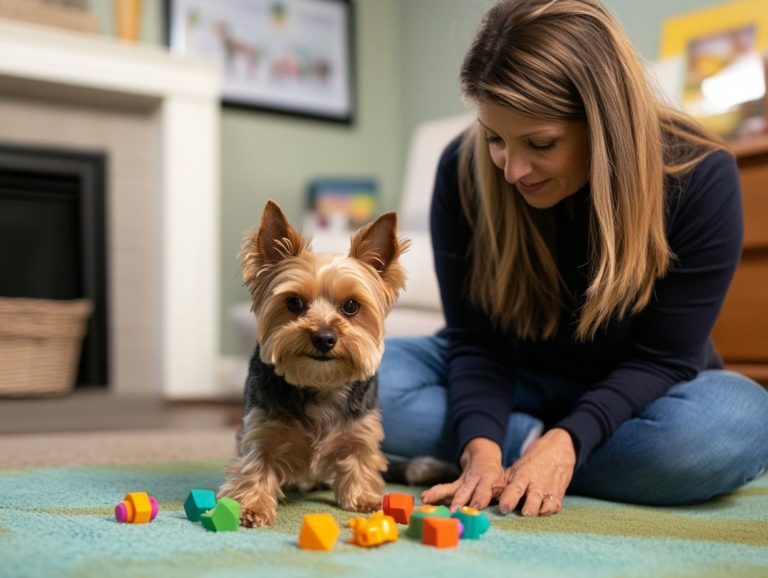Understanding Your Pet’s Anxiety: Causes and Solutions
Pet anxiety is a common issue that deeply affects our furry friends! Just like you, pets can experience stress and fear, triggered by a variety of factors ranging from environmental changes to genetic predispositions. This article delves into what pet anxiety truly is, how to identify its signs, and the many causes behind it.
It also examines effective treatment options, including medications and behavioral therapies, along with prevention and training strategies to help you create a calming environment for your pet. Understanding and addressing pet anxiety is crucial for nurturing a happy, healthy life for your beloved companion.
Contents
Key Takeaways:

- Anxiety in pets can manifest in various ways, including behavioral changes and physical symptoms. It is important for pet owners to recognize and address these signs.
- Environmental and behavioral factors, including socialization, as well as medical conditions and genetics, can all contribute to pet anxiety. Identifying the underlying cause is essential for effective treatment and prevention.
- Create a calm space and encourage social interactions! Utilizing techniques such as medications, natural therapies, and behavioral therapy can help alleviate pet anxiety and promote a happy and healthy pet.
What is Pet Anxiety?
Pet anxiety, especially in dogs, is a pressing concern that impacts not only the well-being of your furry friend but also your own peace of mind. Understanding the effects of age on pet anxiety can help address this anxiety, which can manifest in various behavioral issues and symptoms, often triggered by a range of factors such as environmental changes and genetic predispositions.
As a pet owner, it s essential to grasp the nature of this condition to provide the appropriate support and care. The AKC, Merck Veterinary Manual, and veterinarians stress the importance of recognizing these issues early on. Doing so can help prevent escalation and enhance your dog s overall quality of life.
Defining and Identifying Anxiety in Pets
Identifying anxiety in your pets starts with recognizing the symptoms that signal distress. You might notice excessive barking or destructive behavior in various situations, and understanding the role of diet in pet anxiety can also help address these issues.
Observing your pet’s behavior in different environments can reveal a wealth of information about their emotional state. For example, signs of separation anxiety may present as frantic attempts to escape, drooling, or inappropriate urination when left alone. Fear-related anxiety can manifest as trembling or cowering in response to loud noises like thunder or fireworks.
To gain a deeper understanding of these issues, closely monitor your animal s reactions and consult with a veterinarian. They can provide valuable insights into behavioral patterns and age-related mental decline, recommending effective treatment options tailored to your pet’s specific needs.
Causes of Pet Anxiety
Understanding the causes of pet anxiety is crucial for effective management. These anxieties can arise from various environmental and behavioral factors, as well as genetic predispositions that certain breeds may have toward anxiety disorders. For a deeper insight, consider understanding the needs of anxious pets.
Many dogs may show signs of anxiety due to changes in their environment, insufficient socialization, or even age-related mental decline, which affects their mental health as they age.
By identifying these factors, you can customize your approach to treatment, ensuring your furry companion receives the care they truly need.
Environmental and Behavioral Factors
Environmental and behavioral factors significantly influence the development of anxiety in pets. Excessive noise from thunderstorms or fireworks can lead to stress and noticeable behavioral issues.
Changes in household dynamics like welcoming a new family member or losing a cherished companion can create an unstable environment for these sensitive animals. This instability often manifests as behaviors such as aggression, which may be a direct response to the heightened anxiety they face.
Understanding these triggers is essential for you as a pet owner. By recognizing the signs of distress, you can explore various management strategies, including:
- Creating a safe space for your pets
- Using calming products, CBD oil, or other natural therapies
- Seeking professional help
Implementing such proactive measures can greatly alleviate tension and enhance the overall well-being of your furry companions.
Medical Conditions and Genetics

Certain medical conditions and genetic factors can play a significant role in the development of separation anxiety in your pets, leading to heightened distress when they’re left alone.
For instance, underlying health issues like thyroid imbalances or neurological disorders can intensify feelings of fear and uncertainty in animals, making them more prone to anxiety-related behaviors and symptoms. Additionally, some breeds have genetic predispositions that render them more susceptible to anxiety disorders. Breeds such as Border Collies and Dachshunds, known for their sensitivity, may feel anxiety more acutely than others.
This situation highlights the importance of consulting with a veterinarian who can thoroughly assess the symptoms and craft a tailored treatment plan, ensuring that both the physical and emotional aspects of your pet’s health are properly addressed.
Signs and Symptoms of Pet Anxiety
Spotting the signs of pet anxiety can change your furry friend’s life! Early identification paves the way for effective prevention and treatment strategies, and understanding the cost of pet anxiety experts can be a crucial part of that journey.
Look out for common symptoms such as excessive barking, destructive behavior, or shifts in eating habits, as each can signal an underlying anxiety disorder. By understanding the connection between pet anxiety and barking, you enable yourself to take proactive steps in alleviating your pet’s distress, ensuring their well-being and happiness.
Recognizing and Addressing Behavioral Changes
Recognizing and addressing behavioral changes in your pets is crucial for effectively managing their anxiety. If you notice worsening symptoms, consider exploring what to do if your pet’s anxiety worsens alongside targeted training strategies and natural therapies.
You might notice these changes manifesting as excessive barking, destructive chewing, or withdrawal from social interactions, all of which signal that something isn’t quite right. Staying observant is essential; early recognition can pave the way for more effective intervention.
By implementing positive reinforcement during training sessions and gradually introducing calming techniques like creating a safe space or incorporating natural solutions such as CBD oil you can significantly reduce anxiety levels. Modifying routines and environments can help alleviate stressors, fostering a more relaxed atmosphere that promotes stability and confidence in your pets.
Treatment Options for Pet Anxiety
In terms of addressing your pet’s anxiety, you’ll find a range of treatment options at your disposal, including behavioral therapy and training techniques, as well as insights from what your vet wants you to know about anxiety and medications prescribed by your veterinarian.
Some medications, known as Selective Serotonin Reuptake Inhibitors (SSRIs), like fluoxetine and clomipramine, can help alleviate anxiety symptoms in dogs, and they often work even better when combined with behavioral therapies.
Having a clear understanding of these treatment pathways is crucial for anyone looking to provide the best support for their anxious companions. Start identifying the signs today to help your pet feel better tomorrow!
Medications and Behavioral Therapy
Medications combined with behavioral therapy offer a comprehensive approach to treating anxiety in pets. CBD oil has emerged as a favored natural remedy alongside traditional medications.
While prescription medications, such as selective serotonin reuptake inhibitors (SSRIs) like fluoxetine and clomipramine, can be quite effective for severe anxiety, natural alternatives like chamomile and valerian root are gaining popularity for their soothing properties. You may find yourself drawn to CBD oil due to its minimal side effects and easy administration. However, it s important to understand that medications alone may not fully address anxiety issues.
Incorporating behavioral therapy techniques, such as getting pets used to things that scare them and rewarding good behavior, can significantly enhance the effectiveness of these treatments. This approach promotes a more balanced emotional state in pets, ultimately improving their overall quality of life.
Preventing Pet Anxiety

You can prevent pet anxiety by creating a peaceful home and prioritizing proper socialization through effective training techniques. These elements are crucial for ensuring that your dog thrives without anxiety disorders.
By taking proactive steps to cultivate a positive atmosphere, you can significantly reduce the chances of fear-based reactions in stressful situations for your beloved pet.
Creating a Calming Environment
Creating a calming environment is essential for reducing stress and preventing anxiety in your pets, especially those sensitive to noise phobias.
To achieve this, focus on several practical strategies that enhance their comfort and quietness. One effective approach is to designate a cozy retreat filled with soft bedding and familiar toys, giving your pet a secure personal space. Consider using soundproofing methods like thick curtains or plush rugs to dampen outside noises.
Using calming scents like lavender through essential oil diffusers or pet-safe sprays can greatly help soothe their nerves. Maintaining a routine is also beneficial, providing structure and predictability that eases anxious feelings and encourages relaxation.
Proper Socialization and Training Techniques
Proper socialization and effective training techniques are crucial for preventing anxiety and addressing potential behavioral issues in dogs.
By introducing your dog to various environments, people, and other animals, you can cultivate a well-adjusted companion. Gradual exposure is essential; for instance, when you take your dog to a new park, start with short visits during quieter times.
Utilizing rewarding good behavior during these outings can make all the difference. Keeping training sessions enjoyable and rewarding helps build your dog’s confidence, allowing them to adapt more easily to changing situations.
Additionally, incorporating obedience training enhances communication between you and your dog, fostering a sense of security that ultimately leads to a more relaxed and sociable pet.
Frequently Asked Questions
What are some common causes of pet anxiety?
Pet anxiety can be caused by various factors, including separation from their owners, changes in routine or environment, lack of socialization, past traumatic experiences, and even certain medical conditions, such as cognitive dysfunction syndrome.
How can I tell if my pet is suffering from anxiety?

Some common signs of pet anxiety include excessive barking or meowing, destructive behavior, changes in appetite, excessive licking or grooming, and restlessness. If you notice these symptoms in your pet, it’s crucial to consult with a veterinarian immediately to determine the root cause and explore appropriate treatment options.
What are some solutions for managing my pet’s anxiety?
Managing your pet’s anxiety can be achieved with various approaches. Options include behavior modification, natural therapies like essential oils, calming supplements such as CBD oil, and veterinarian-prescribed medications.
Finding the right method for your pet is crucial. Be sure to consult with your vet, especially when considering medications like SSRIs, which are used to treat anxiety.
Is it possible for my pet’s anxiety to improve?
Yes, your pet’s anxiety can improve with a proper treatment plan and consistency. Remember, every pet is unique, so finding the right solution may take time.
Stay patient and collaborate closely with your veterinarian. They will guide you to the best options for your furry friend.
Can I prevent my pet from developing anxiety?
While some pets are more prone to anxiety, there are proactive steps you can take. Proper socialization, a consistent routine, and a safe environment are key.
Training strategies that build confidence can also help prevent anxiety disorders.
Should I seek professional help for my pet’s anxiety?
If your pet’s anxiety significantly affects their life, seeking professional help is vital. Understanding the benefits of understanding your pet’s anxiety can guide you, as a veterinarian or animal behaviorist can identify the root cause of the anxiety.
They will create a tailored treatment plan suited to your pet’s needs, often drawing on trusted resources like Cornell University College of Veterinary Medicine.






